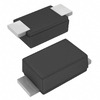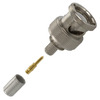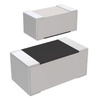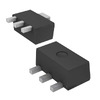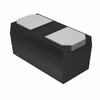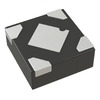LD1117 Voltage Regulator: Pinout, Alternatives, and Specifications
LD1117, celebrated for its efficiency as a positive voltage regulator, shines in electronic applications for its low voltage drop performance. This articles explores the intricate operational mechanisms and diverse applications of LD1117 in electronic circuits. Grasping its function can greatly enhance the pursuits of individuals focused on designing and refining electronic devices, providing illuminating perspectives on attaining consistent power efficiency and stability. The exploration of LD1117's capabilities allows for a deeper appreciation of how it contributes to the success of electronic solutions.Catalog
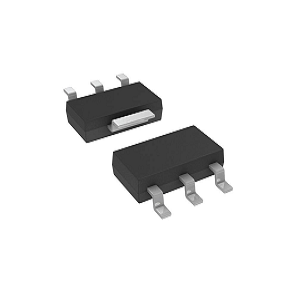
Overview of the LD1117
The LD1117 distinguishes itself with precise voltage regulation, achieving a maximum dropout of just 1V. Its capacity to deliver up to 800 mA of current is attractive for a variety of demanding applications, including energizing microcontrollers and operating small motors. These characteristics promote confidence in contexts that require consistent voltage output, showcasing its versatility in electronic circuit design. The device meets a wide range of voltage requirements with fixed outputs spanning from 1.2V to 5.0V. Moreover, an adjustable version provides a reference voltage of 1.25V, offering the creative latitude to customize voltage output for specific needs. This adjustability plays a role in projects that require different voltage levels to suit diverse components or experimental settings.
With a variety of packaging options, SOT-223, DPAK, SO-8, and TO-220, the LD1117 presents with choices that align with spatial and thermal demands of their work. This packaging variety aids in seamless integration into numerous PCB designs, supporting both compact form factors and efficient heat dissipation. Many value these elements for their role in extending the life of electronic components and securing stable performance even under fluctuating environmental conditions. Managing heat dissipation effectively by choosing the right packaging option is a great consideration. For example, using the correct heat sink or spreader can greatly reduce the likelihood of thermal-related issues. Diving into the intricacies of load and line regulation when working with LD1117 unveils optimization possibilities that enhance power management efficiency.
The LD1117 emerges as a functional and dependable component for voltage regulation needs. Its expansive output range, current handling capability, and variety of package options render it an approachable choice. By embracing its adaptable nature and gaining insight into its operational characteristics, you can capitalize on its advantages to boost the performance and dependability of their electronic ventures.
LD1117 Pin Configuration
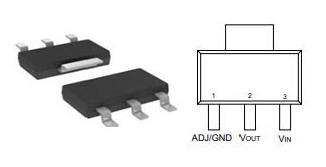
|
Pin Number |
Pin Name |
Description |
|
1 |
Ground |
Ground Pin – connected to the ground of the system. |
|
2 |
Vout |
Regulated Output Voltage |
|
3 |
Vin |
Input Voltage that is to be regulated |
LD1117 Symbol, Footprint, and CAD Model
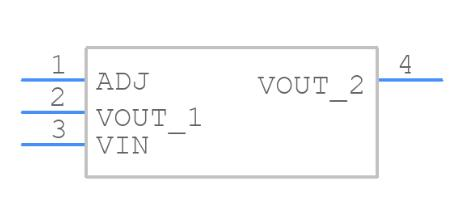
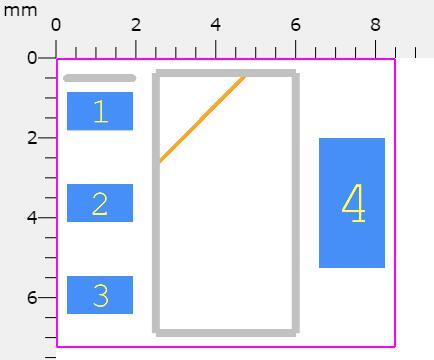
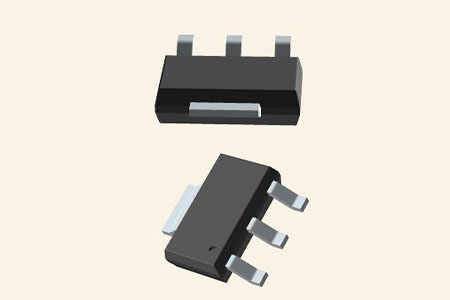
Features of the LD1117
Versatile Output Parameters
The LD1117 regulator stands out for providing an output current reaching up to 800 mA. Its adaptability is portrayed through several fixed voltage configurations and adjustable voltage settings, which cater to diverse needs. This adaptability finds its place effectively in consumer electronics, where precise voltage levels closely influence device performance, echoing desires for precision and satisfaction.
Internal Safeguard Features
An aspect of the LD1117 is its internal mechanisms that shield against current overload and thermal stress. Such protections bolster device reliability, proving especially valuable in erratic environments prone to voltage shifts. Others often rely on these safeguards, attributing the enduring stability of their projects to these thoughtfully engineered features, paralleling a sense of security in human endeavors.
Supply Voltage Noise Mitigation
An important facet of the regulator is its capacity to maintain up to 75 dB of supply voltage rejection, underscoring its effectiveness in curbing power supply noise. This trait proves advantageous in sensitive applications where maintaining signal integrity is important. With application and occasional field adjustments, many often realize that these noise-minimizing properties enhance overall system functionality, mirroring the quest for clarity and coherence.
Functional Diagram of LD1117
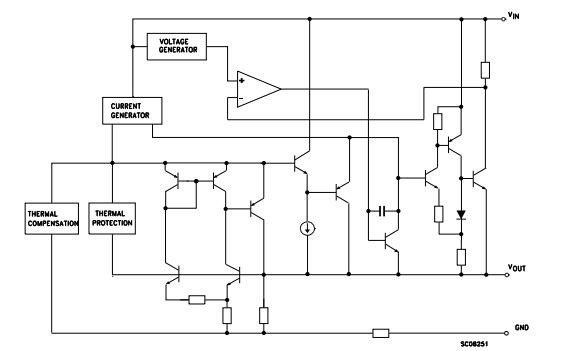
Applications of the LD1117
Prolonged Battery Efficiency
The LD1117 has a special place in advancing battery efficiency. Its talent lies in maintaining a constant output voltage even when battery power wavers. In devices like portable electronics, it extends battery life and delivers steady performance. Emphasizing energy efficiency, today's devices are often engineered with meticulous care, balancing load needs and using the LD1117 to precisely manage power flow while curbing energy waste.
Versatile Power Supply Adaptation
When it comes to variable power supplies, the LD1117's true strength is its adaptability to diverse voltage demands. This versatility is appreciated in circuit designs catering to multiple operational conditions. Many craft configurations where the LD1117 fine-tunes the output to meet specific voltage requirements of circuit segments. This doesn't just enhance performance but also acts as a safeguard against potential over-voltage hazards, showcasing prudent risk approaches in electronic design.
Safeguards in Current Regulation
The LD1117's role in current limiting circuits stands out for controlling excessive current that could compromise components. In crafting such circuits, many trust the regulator to ensure both safety and longevity of electronic systems. By imposing calculated limits, the LD1117 acts as a protective barrier against short circuits and overloads in sensitive electronics where reliability holds importance.
Seamless Integration in Consumer Electronics and PCs
In PCs and consumer electronics, the LD1117 helps achieve effective power distribution and voltage control, ensuring consistent device performance under shifting loads. Its compactness and reliability warrant its popularity. With increasing demand for devices that are both power-efficient and responsive, integrating the LD1117 can enhance system performance.
Reliable Automotive Solutions
In automotive scenarios like motor controllers, the LD1117's resilience in tough conditions is well-regarded. The automotive domain consistently employs regulators such as the LD1117 to ensure steady power delivery for vehicle safety and performance. Withstanding high temperatures and vibrations, it meets the industry's rigorous durability standards. Insights from automotive engineering propose that using the LD1117 enriches the reliability of powertrain systems, pushing forward innovations in both electric and hybrid vehicle technologies.
Circuit Designs for LD1117 Applications


Integrating LD1117 in Circuits
Establishing proper fixed voltage regulation requires accurate connections between the input, output, and ground pins. Achieving consistent voltage outputs is need for electronic projects that are sensitive to variations, such as those involving low-noise amplifiers or microcontrollers. Ensuring a clean ground path contributes to the circuitry's stability and reliability.
When non-standard voltages are required, resistors R1 and R2 can be utilized for precise voltage adjustments, offering adaptability during prototyping or testing. The key to success lies in selecting resistor values that not only meet the specific voltage needs but also optimize component function and thermal balance, ensuring prolonged device functionality. Using capacitors can greatly improve ripple rejection, leading to smoother voltage delivery for precise applications. This practice, often verified in lab environments, aids in stabilizing transient responses and minimizing noise. Others highlight that choosing capacitors with low Equivalent Series Resistance (ESR) enhances overall performance by reducing fluctuations and increasing the circuit's robustness. When applying the LD1117, it is need to consider these strategies for achieving specific electrical outputs while factoring in real-world demands for reliability and adaptability. Analyzing different approaches underscores their role in a wide range of electronic circuit designs, enhancing the device's applicability to various engineering challenges.
LD1117 Technical Specifications
Technical characteristics, specifications, and attributes of the STMicroelectronics LD1117, as well as parts comparable to the LD1117STR.
|
Type |
Parameter |
|
Lifecycle Status |
ACTIVE (Last Updated: 7 months ago) |
|
Contact Plating |
Tin |
|
Mounting Type |
Surface Mount |
|
Number of Pins |
3 |
|
Operating Temperature |
0°C~125°C |
|
JESD-609 Code |
e3 |
|
Moisture Sensitivity Level (MSL) |
1 (Unlimited) |
|
Termination |
SMD/SMT |
|
Packing Method |
TR, 7 INCH |
|
Terminal Position |
DUAL |
|
Number of Functions |
1 |
|
Pin Count |
3 |
|
Factory Lead Time |
8 Weeks |
|
Mount |
Surface Mount |
|
Package / Case |
TO-261-4, TO-261AA |
|
Weight |
4.535924g |
|
Packaging |
Tape & Reel (TR) |
|
Part Status |
Active |
|
Number of Terminations |
4 |
|
ECCN Code |
EAR99 |
|
Max Power Dissipation |
12W |
|
Terminal Form |
GULL WING |
|
Base Part Number |
LD1117 |
|
JESD-30 Code |
R-PDSO-G4 |
|
Number of Outputs |
1 |
|
Output Type |
Adjustable |
|
Max Supply Voltage |
15V |
|
Power Dissipation |
12W |
|
Accuracy |
1% |
|
Number of Regulators |
1 |
|
Protection Features |
Over Current, Over Temperature |
|
PSRR |
75dB (120Hz) |
|
Dropout Voltage |
1.1V |
|
Min Output Voltage |
1.25V |
|
Output Voltage Accuracy |
1% |
|
Height |
1.8mm |
|
Width |
3.5mm |
|
Radiation Hardening |
No |
|
Lead Free |
Lead Free |
|
Output Voltage |
15V |
|
Max Output Current |
1.3A |
|
Output Configuration |
Positive |
|
Quiescent Current |
10mA |
|
Max Output Voltage |
15V |
|
Min Input Voltage |
2.35V |
|
Voltage Dropout (Max) |
1.2V @ 800mA |
|
Reference Voltage |
1.262V |
|
Dropout Voltage1-Nom |
1.1V |
|
Input Bias Current |
5mA |
|
Load Regulation-Max(%) |
0.40% |
|
Length |
6.5mm |
|
REACH SVHC |
No SVHC |
|
RoHS Status |
ROHS3 Compliant |
Alternatives of the LD1117
|
Part Number |
Manufacturer |
Package / Case |
Number of Pins |
Number of Outputs |
Max Output Current |
Min Input Voltage |
Min Output Voltage |
Output Voltage |
Max Output Voltage |
Accuracy |
|
LD1117STR |
STMicroelectronics |
TO-261-4, TO-261AA |
3 |
1 |
1.3 A |
2.35 V |
1.25 V |
15 V |
15 V |
1% |
|
TLV1117LV33DCYR |
Texas Instruments |
TO-261-4, TO-261AA |
4 |
1 |
1.2 A |
2.75 V |
1.25 V |
15 V |
- |
2% |
|
TLV1117LV28DCYR |
Texas Instruments |
TO-261-4, TO-261AA |
4 |
1 |
1:00 AM |
2 V |
1.5 V |
1.5 V |
1.5 V |
2% |
|
LD1117ASTR |
STMicroelectronics |
TO-261-4, TO-261AA |
4 |
1 |
1:00 AM |
2 V |
2.8 V |
2.8 V |
2.8 V |
2% |
|
TLV1117LV15DCYR |
Texas Instruments |
TO-261-4, TO-261AA |
4 |
1 |
1:00 AM |
2 V |
3.3 V |
3.3 V |
3.3 V |
2% |
Packaging of LD1117

LD1117 Manufacturer Information
STMicroelectronics stands as a trailblazer in the realm of semiconductor innovation, channeling years of profound expertise in system-on-chip (SoC) solutions into the LD1117. This commitment to cutting-edge technology not only enriches the LD1117’s capabilities but aligns seamlessly with a vast array of applications. Such dedication, fueled by rigorous research and strategic alliances, has fortified its position as a stalwart in the industry. STMicroelectronics epitomizes this blend by devising solutions like the LD1117 that echo a pledge to sustainability and groundbreaking innovation. The strategic anticipation in addressing forthcoming challenges while upholding high performance establishes an industry benchmark for excellence. The LD1117 from STMicroelectronics exemplifies the company's unwavering pursuit of groundbreaking semiconductor solutions that pair innovative technology with practical application. Its evolution, supported by comprehensive research and industry partnerships, represents an outstanding model of innovation many aspire to emulate. As the semiconductor terrain progresses, STMicroelectronics' technology advancement strategy will continue to be influential in molding the future of integrated circuit design.
Datasheet PDF
LD1117STR Datasheets:
TLV1117LV33DCYR Datasheets:
Copper Wire Base Metal 07/Oct/2014.pdf
TLV1117LV28DCYR Datasheets:
Cylindrical Battery Holders.pdf
LD1117ASTR Datasheets:
TLV1117LV15DCYR Datasheets:
Cylindrical Battery Holders.pdf
About us
ALLELCO LIMITED
Read more
Quick inquiry
Please send an inquiry, we will respond immediately.
Frequently Asked Questions [FAQ]
1. What is LD1117?
The LD1117 regulator is known for managing voltage outputs reaching up to 800 mA. It comes in both fixed and adjustable versions which feature exceptionally low dropout characteristics. For those working with electronic devices, achieving the best performance of each component stands as a central concern. Others often underscore that selecting between fixed and adjustable versions should align with specific design preferences, such as prioritizing efficiency or seeking flexibility.
2. What is a 3v3 voltage regulator?
The 3.3V model consistently delivers the stable output that low-voltage applications demand, supporting currents up to 800 mA. In present-day circuits, where power efficiency and reliability are highly regarded, this ensures the reduction of energy consumption while sustaining performance. Knowledgeable recognize the necessity of this stability in crafting efficient designs.
3. How do I reduce 5V to 3.3 V?
Converting from 5V to 3.3V can be done using a simple resistive divider circuit. Yet, for those seeking greater accuracy, the addition of precisely selected resistors is recommended. Those skilled in circuit design frequently analyze how temperature fluctuations might affect resistor performance, adjusting choices as needed to uphold voltage accuracy.
4. What conditions to operate LD1117?
Devices incorporating SOT-223 and DPAK packages combine operational efficiency with compact form. Implementing a 10 µF capacitor in these designs notably enhances system stability against varying temperature conditions. Many often point to the role of these minimal yet impactful components in achieving precision and sustained reliability across diverse applications.

TC4420CPA: Pinout, Specifications, and Datasheet
on November 5th
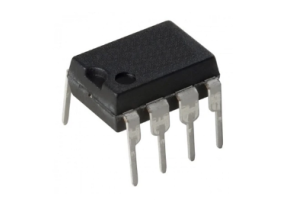
Exploring the LF356 Op-Amp: Pinout and Package Specifications
on November 4th
Popular Posts
-

What is GND in the circuit?
on January 1th 2915
-

RJ-45 Connector Guide: RJ-45 Connector Color Codes, Wiring Schemes, R-J45 Applications, RJ-45 Datasheets
on January 1th 2475
-

Fiber Connector Types: SC Vs LC And LC Vs MTP
on January 1th 2064
-

Understanding Power Supply Voltages in Electronics VCC, VDD, VEE, VSS, and GND
on November 8th 1852
-

Comparison Between DB9 and RS232
on January 1th 1749
-

What Is An LR44 Battery?
Electricity, that ubiquitous force, quietly permeates every aspect of our daily lives, from trivial gadgets to life-threatening medical equipment, it plays a silent role. However, truly grasping this energy, especially how to store and efficiently output it, is no easy task. It is against this background that this article will focus on a type of coin cell battery that may seem insignificant on the...on January 1th 1702
-

Understanding the Fundamentals:Inductance Resistance, andCapacitance
In the intricate dance of electrical engineering, a trio of fundamental elements takes center stage: inductance, resistance, and capacitance. Each bears unique traits that dictate the dynamic rhythms of electronic circuits. Here, we embark on a journey to decipher the complexities of these components, to uncover their distinct roles and practical uses within the vast electrical orchestra. Inductan...on January 1th 1646
-

CR2430 Battery Comprehensive Guide: Specifications, Applications and Comparison to CR2032 Batteries
What is CR2430 battery ?Benefits of CR2430 BatteriesNormCR2430 Battery ApplicationsCR2430 EquivalentCR2430 VS CR2032Battery CR2430 SizeWhat to look for when buying the CR2430 and equivalentsData Sheet PDFFrequently Asked Questions Batteries are the heart of small electronic devices. Among the many types available, coin cells play a crucial role, commonly found in calculators, remote controls, and ...on January 1th 1529
-

What Is RF and Why Do We Use It?
Radio Frequency (RF) technology is a key part of modern wireless communication, enabling data transmission over long distances without physical connections. This article delves into the basics of RF, explaining how electromagnetic radiation (EMR) makes RF communication possible. We will explore the principles of EMR, the creation and control of RF signals, and their wide-ranging uses. The article ...on January 1th 1519
-

CR2450 vs CR2032: Can The Battery Be Used Instead?
Lithium manganese batteries do have some similarities with other lithium batteries. High energy density and long service life are the characteristics they have in common. This kind of battery has won the trust and favor of many consumers because of its unique safety. Expensive tech gadgets? Small appliances in our homes? Look around and you'll see them everywhere. Among these many lithium-manganes...on January 1th 1496













